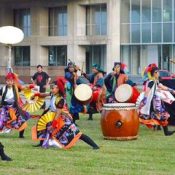
November 6, 2017 Ryukyu Shimpo
The Worldwide Eisa Festival was held at the National Theatre Okinawa in Urasoe City on November 4 and 5.
Nineteen teams competed in the Grand Prix match, and CHURASA took the first prize. CHURASA.
JR also won the first prize in the junior category, in which a total of ten teams competed.
CHURASA JR. performed with a big drum that was donated by the parents of one of their members who passed away two years ago.
The team leader Chikashi Tamaki shared his reflections; “we really wanted to bring the drum and the member’s spirit with the team to the festival.
Although we had a regrettable experience when we lost at the final match two years ago, we are very happy that we got the first prize together this time.”
REQUIOS received the second prize, and Kazenomai followed with the third prize.
Kazenomai Jr. won the second prize in the Jr. category, and Takanabe Shinkancha won the third.
(English translation by T&CT and Sayaka Sakuma)
Go to Japanese

November 17, 2017 Ryukyu Shimpo
The first regular direct flight between Naha Airport in Okinawa and Changi International Airport in Singapore begins service on the 17th.
Singapore Ambassador to Japan Lui Tuck Yew who arrived in Okinawa on the 16th to attend the opening ceremony visited Governor Takeshi Onaga.
The ambassador expressed his appreciation for the opportunity to promote exchange between Singapore and Okinawa through the opening of the route.
Governor Onaga expressed his willingness to build the relationship beyond tourism, saying that “We can build a mutual win-win exchange as a nodal point between Japan and Singapore.”
It is the first time regular flights to Singapore have been opened, though there were direct charter flights for a limited time.
Singaporeʻs low-cost carrier Jetstar Asia Airlines operates three times a week on Monday, Friday, and Sunday.
It was a long-sought goal for Okinawa to open a route to Singapore which has become the international financial hub of Southeast Asia.
In March 2014, the prefecture signed a cooperation agreement with the Changi Airport Group to strengthen the airline network.
In 2015 when Governor Onaga took up a post, the governor opened a prefecture office in Singapore and visited Jetstar to request that the service be launched.
Ambassador Lui mentioned the growing recognition of Okinawa as a world resort destination as he said in an interview that “Okinawa was the most popular new destination in a Jetstar survey.
The opening of the route will be convenient for Malaysia and Indonesia as well.”
Furthermore, he said, “There is a lot to learn from Okinawa about longevity and health.
The Okinawa Institute of Science and Technology Graduate University is also renowned worldwide, and further cooperation can be deepened in the field of science and technology.”
Governor Onaga said, “Naha Airport has increased the accumulation of cargoes which will strengthen not only tourism but also physical distribution.
We hope to create a flow of people and things from Singapore to Japan and from Japan to Singapore via Okinawa.”
The prefecture expects that the opening of the route will lead to an increase in visitors from Europe and Australia through Changi Airport.
The Prefectural Government Culture, Tourism and Sports Division Director Kadekaru Takao said, “Our request was rejected ten years ago due to ʻinefficiency of relaying.’
We will connect with Singapore, and thereby also strengthen our promotion campaign to Europe and Australia.”
(English translation by T&CT and Megumi Chibana)
Go to Japanese
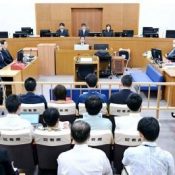
November 17, 2017 Ryukyu Shimpo
The first day of hearings in the trial of the 33-year-old ex-Marine accused of rape resulting in death and murder of an Okinawan woman while employed as a civilian base worker in April, 2016 began today at Naha District Court (Judge Toshihiro Shibata presiding).
While the defendant has pled guilty to the charges of rape resulting in death and abandoning the victim’s body, he has denied the charges of premeditated murder, saying, “I did not mean to kill her.”
The defendant’s lawyer also argued that the defendant’s actions did not constitute murder. Furthermore, the defendant invoked the right against self-incrimination, and refused to testify.
During the prosecution’s cross-examination attempting to confirm the statement describing the incident immediately after the arrest, the defendant refused to answer any questions.
While the possibility of a court testimony by the defendant was anticipated after invoking the right to remain silent during the police investigation, the silence continued.
During the arraignment the defense stated, “There was no intention to kill. The defendant intended knocking the victim unconscious and raping her at a hotel, after which he would release her.
However, he could not proceed with his plan when the woman failed to lose consciousness.
In their opening statement, the prosecution argued that the defendant intended to kill the woman after raping her in the road, the defendant’s possession of a slapper (stick used to knock someone unconscious) a knife and a suitcase indicated both pre-meditation and planning.
After which, the defendant went to Uruma to find a victim.
After striking the victim on the back of the head multiple times with the slapper, the defendant strangled the woman by hand, and stabbed her repeatedly in the neck with the knife, which the prosecution stresses is “recognized as intent to kill.”
Conversely, the defense argued that the striking with the slapper and strangulation was only in attempt to render the victim unconscious, and not with intent to kill, and that it is possible that the victim died from injuries sustained when the defendant threw the victim into the grass near the road.
In the indictment, the defendant is accused of intent to murder a 20-year-old woman walking on the road in Uruma by striking her in the head, strangling her with both hands and stabbing her repeatedly in the neck around 10 p.m. on April 20, 2016.
It also states that the defendant sought to kill the victim after abandoning the violent assault.
The second day of the trial is set for 10 a.m. on November 17.
The victim’s father will give a statement, and there will be another attempt to examine the defendant.
(English translation by T&CT and Sam Grieb)
Go to Japanese
November 17, 2017 Ryukyu Shimpo
The incident was a tragic one in which the life of a 20-year old woman with a bright future ahead of her was stolen away.
Although it is the right of the defendant, his exercise of the right to remain silent is difficult to accept.
A former U.S. Marine and then-military contractor, defendant Kenneth Franklin Shinzato (formerly Gadson) stands accused of murder and other crimes on the charge of raping and killing a female office worker in Uruma City in April of last year.
His trial with a jury began at the Naha District Court.
The defendant denied the charge of murder, stating in the arraignment that he did not intend to kill the woman.
He plead guilty to the charges of rape resulting in death and disposal of a body.
In the later defendant questioning, the defendant exercised his right to remain silent.
He should at least apologize to the victim and her family.
Even more than one year after the incident, it is obvious that the defendant feels no remorse.
In February of this year, in a letter sent to Stars and Stripes, the quasi-official newspaper of the U.S. military, the defendant stated that because under the Japanese legal system rape-related crimes require an official complaint from the victim to be prosecuted and rates of reporting sexual assault are rare in Japan, he had no fear of being arrested.
He might as well be saying that it’s fine to do anything he wants as long as he is not arrested for it. The defendant’s decision to exercise the right to remain silent likely stems from his lack of law-abiding spirit and consciousness of human rights.
If it is not determined that a defendant had an intent to kill, killing another human being is not charged as murder.
If the defendant is charged just with rape resulting in death, he will face only a temporary sentence instead of a life sentence.
If this is why the defendant denied intent to kill and chose to remain silent, it is outrageous.
The defendant should give a proper answer to the question, “Why my daughter? Why did she have to be killed?” for which the victim’s father sought clarity in his messages and writings.
The defendant assaulted a woman to satisfy his own desires, and he robbed her of her future.
He should be keenly aware of his responsibility to squarely face that fact.
His duty is not to try to protect himself, but to reveal the truth and apologize.
The prosecutors assert that the defendant had an intent to kill because he stabbed the victim several times in the neck.
He prepared a suitcase to carry her body and changed his clothes at a hotel after the crime, indicating that the crime was planned.
The assertions of the prosecution and the defense are at odds, and the jurors should accurately determine the defendant’s intent to kill.
The defendant shows little consciousness of having committed a crime, having stated in writing that the woman was at fault for being where she was at that time.
We hope for a ruling that the family of the deceased can accept.
Many Okinawans were heartbroken by the tragedy of a woman whose future was stolen away and by the deep sorrow of her family.
Such a tragic incident must never happen again.
As the victim’s father states, the effective measure to prevent reoccurrence is to remove the bases as soon as possible.
This incident hit home the fact that because of the presence of U.S. bases, anyone might become a victim.
The government should wake up to its grave responsibility for continually failing to remedy the situation.
(English translation by T&CT)
Go to Japanese
November 17, 2017 Ryukyu Shimpo
On November 16, the Okinawa Area Coordinator (OAC) Lawrence Nicholson announced that the Ministry of Defense (MOD) will establish the Amphibious Rapid Deployment Brigade (ARDB), with future deployment to a U.S. base in Okinawa in mind. The ARDB is referred to as Japan’s version of the Marine Corps, and will be part of Japan’s Ground Self-Defense Forces (JGSDF).
Nicholson made this announcement in an interview at Camp Courtney in Uruma City. He has heard that the ARDB will send a regiment to Okinawa but does not know the period of deployment, which is up to the MOD’s discretion. This is the first occasion that a U.S.-Japan authority has made reference to deployment of the ARDB.
Nicholson hypothesized that the ARDB will be deployed to Camp Schwab in Nago City, or to Camp Hansen which stretches in part through Ginoza Village.
In addition, Nicholson voiced his hope that opening a U.S. base in Okinawa to shared use with the SDF would provide an example for interoperability between the forces and set the stage for more joint-use bases.
He voiced his concern about a current shortcoming in Okinawa, namely that the bases are not joint bases. “If you went to Hokkaido or Camp Fuji you will see U.S. Marines training with JGSDF, so why not here?” he pondered.
(English translation by T&CT and Erin Jones)
Go to japanese

November 16, 2017 Ryukyu Shimpo
The prefecture has labeled the environmental issue, involving dust and noise from dump trucks that come/go to the port, as a “new development.”
As a result, the prefecture announced on November 15 that it is considering revoking the permission to use Oku Port for transporting materials for the new base construction.
Oku Port in Kunigami Village has been used for transporting materials by sea for the seawall construction for the new Henoko base, also known as the relocation of the U.S. Military Futenma Air Station.
On the same day, the prefecture requested that the Okinawa Defense Bureau file the paperwork to stop the maritime transport using the Oku Port and change the approval status.
Governor Takeshi Onaga who had a press conference that same evening said, “We were unable to make the Oku residents aware that the dump trucks would be contributing to that much dust on the roads.
It is a new situation and we aren’t sure what will come about with the Ports and Harbors Law, but we want to make sure we handle it accordingly.”
After permissioning to use the quay wall and land for port facilities in September, the prefecture created the “Standards for Screening the Permission to Use the Land for Port Facilities” on November 7.
It includes the phrase, “No concern over corruption of environment.”
It seems that the prefecture is considering revoking the permission by applying this regulation and not permitting an application for renewal.
Regarding the commencement of maritime transport, Governor Onaga criticized the situation by saying, “We had given administrative guidance to hold off execution until the negotiations were done with the prefecture.
It is extremely disappointing that they hastily started the maritime transport without listening to the prefecture’s administrative guidance.”
The permission to use the Oku Port was given despite the prefecture employing various methods to prevent the new base from being constructed.
As a result, there is growing opposition by citizens who are against the new base.
Regarding this, Governor Onaga said, “My feelings are exactly the same as the citizens.
I myself am ashamed of this situation. Naturally, I cannot criticize those who sincerely feel that I have broken my pledge.”
Governor Onaga thereby acknowledged the criticisms toward him.
Regarding the timeframe for which the landfill approval will be revoked, Governor Onaga said, “I will take responsibility.
Right now, I’m not thinking about specifying a time, such as whether it will happen tomorrow or a month later since we are currently confronting a big thing called state power.”
(English translation by T&CT and Chelsea Ashimine)
Go to Japanese
November 13, 2017 Ryukyu Shimpo online edition
Past 7:30 a.m. on November 13, a large boat for use transporting gravel and stones over the ocean was docked at Oku Port in Kunigami Village.
This boat is taking the materials to Henoko, Nago City, for use in constructing a replacement facility for Marine Corps Air Station Futenma.
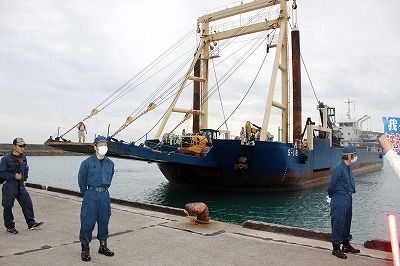
On November 13 at 7:53 a.m. at Oku Port in Kunigami Village, a large boat can be seen waiting at port for the purpose of transporting gravel and such materials over the ocean.
After 9:00 a.m. the same day, dump trucks loaded with gravel and similar materials arrived at Oku Port one after another.
Next, the trucks were seen being loaded onto the boats, and taken away over the water.
The residents of Oku Village gathered at the port to protest.
They said things such as: “This is a place for fishing,” and “Once one destroys nature, the damage is done.”
An 83-year-old woman from Oku said: “This port is a place of relaxation and refreshment, for everyone to come fish between time spent in the fields.
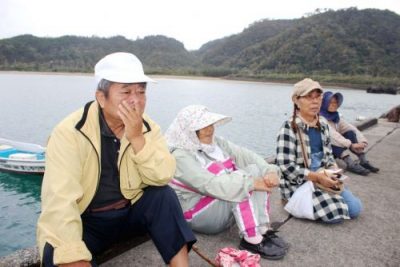
Oku residents gathered at Oku Port in Kunigami Village at 8:04 a.m. on November 13 to protest this use of the port.
I was taken aback when I first learned of this matter from the newspaper.
Without any warning we could no longer go fishing.”
A 73-year-old man added: “What will [the government] accomplish by angering the townsfolk?Regardless of whether we support or oppose the bases, everyone is going to become enraged. This is such a quiet place with but a single road, so we can no longer come and go freely while doing our farming.”
It was confirmed that around 8:30 p.m. the same night, dozens of dump trucks loaded with gravel were heading to Oku Port.
(English translation by T&CT and Erin Jones)
Go to Japanese

November 10, 2017Ryukyu Shimpo
Following the temporary deployment of the U.S. Air Force’s newest stealth fighters F-35As from Hill Air Force Base in Utah to Kadena Air Base, the Kadena Town Council held a special session at which they unanimously adopted a protest resolution and an opinion letter requesting suspension of flight training, immediate withdrawal of F-35As and a ban on the operation of all aircraft from other bases.
The protest resolution and opinion paper included decibel readings of noise pollution since the 7th of this month, when training began.
It also contained complaints from residents stating; “The anger of residents is becoming explosive.”
They called for a prompt reduction of the burden on Kadena Base and an end to any expansion of activities.
On the afternoon of the 10th, citizens will visit Director Koichiro Nakajima of the Okinawa Defense Bureau to express their protest.
They will also complain to the Ministry of Foreign Affairs Okinawa Office, the 18th Wing of the U.S. Air Force, the Okinawa Prefectural Government, and the Prefectural Assembly.
(English translation by T&CT and Megumi Chibana)
Go to Japanese
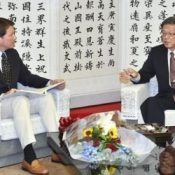
November 14, 2017 Ryukyu Shimpo
Okinawa Governor Takeshi Onaga met with United States Ambassador to Japan William F.
Haggerty at the prefectural office November 13.
This was Ambassador Haggerty’s first meeting with the Governor and his second visit to Okinawa.
Governor Onaga commented on the new base construction that is part of the MCAS Futenma base relocation on U.S. military-heavy Okinawa as “discrimination,” and asked the Ambassador for his opinion.
In response, Ambassador Haggerty said, “I understand your concerns,” and without directly mentioning the new base construction in Henoko, reaffirmed his commitment to progressing the easing of Okinawa’s burden as part of the Japan-U.S. Status of Forces Agreement (SOFA).
For over half of the meeting, Governor Onaga touched on topics such as the Battle of Okinawa and the U.S. base problem which followed, and continued to ask Haggerty for his thoughts.
Governor Onaga also raised his concerns about his visit to the U.S., when his appeals about the Henoko base construction problem were regarded as a domestic Japanese matter, strongly stating, “In the hearts of Okinawans, the U.S. government and military are entirely responsible.
Word of the construction that is displaying grandmothers and grandfathers is making its way throughout the world.
I want you to understand that the base construction in Henoko is calling into doubt Japanese and American democracy.”
Ambassador Haggarty gave his thanks for hosting the U.S. Forces in Japan, and said, “We will continue to support safety and stability in not only Japan, but also in all of Southeast Asia.
” He also stressed his commitment to cooperation between Okinawa, Japan, and the U.S. in continuing to ease the burden on Okinawa, saying, “I agree that we need to cooperate on policies to lessen the effects [of the U.S. military in Japan].”
Ambassador Haggerty also regarded Governor Onaga’s thoughts as “useful information” and indicated that his opinions were shared by the U.S. government. He also said that safety was the “highest priority” in the wake of the U.S. helicopter crash in Takae.
On November 14, Ambassador Haggerty will visit the U.S. bases in Okinawa to hold discussions with U.S. military senior leadership.
(English translation by T&CT and Sam Grieb)
Go to Japanese

November 10, 2017 Ryukyu Shimpo
The British Museum in England, the world’s largest museum, has acquired two ceramic works created by Haruhiko Kaneko, 56, owner of the well-renowned Ishigaki-yaki Pottery Studio in Ishigaki. The two pieces are the “Yohen-taihi tenmoku tea bowl” and the “Hekikai-yuteki tenmoku tea bowl.” Kaneko is the second Okinawan ceramic artist to have his works collected by the British Museum after Isamu Nakamura from Nago.
The “Yohen” tea bowl was made in 2010. It catches the light as if it were inlaid with gems, and glitters with an iridescent sparkle. The “Hekikai” tea bowl uses a glaze made with a 1000 year-old technique, characterized by the texture of the glaze’s iron base exuding from the bowl.
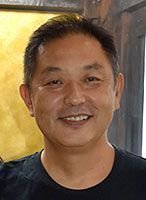
Haruhiko Kaneko
Both pieces are bade by fusing glass and ceramics, making the bottom of each bowl shine with a bright blue gradient reminiscent of the Okinawan sea. The pieces were acquired by the museum September 20.
Kaneko, who referred to the acquisition by the British Museum as a “dream,” said happily, “It is a great honor. This will serve as great PR for Yaeyama and Ishigaki Island, as visitors from all over the world come to the museum.”
“I think that the fusion of glass and ceramics was what [the museum] valued. I want to break into new genres, and create even better works,” he continued with resolve and passion.
(English tanslation by T&CT and Sam Grieb)
Go to Japanese











 Webcam(Kokusai Street)
Webcam(Kokusai Street)


